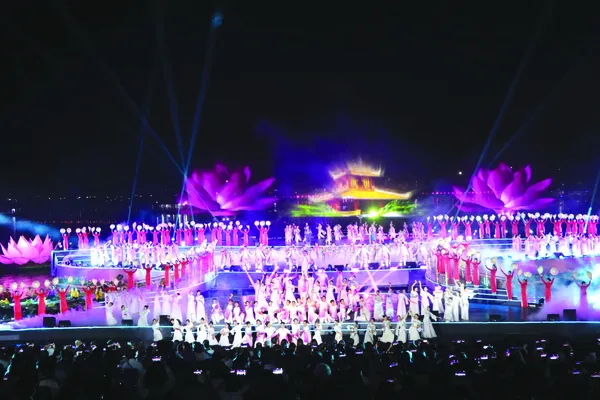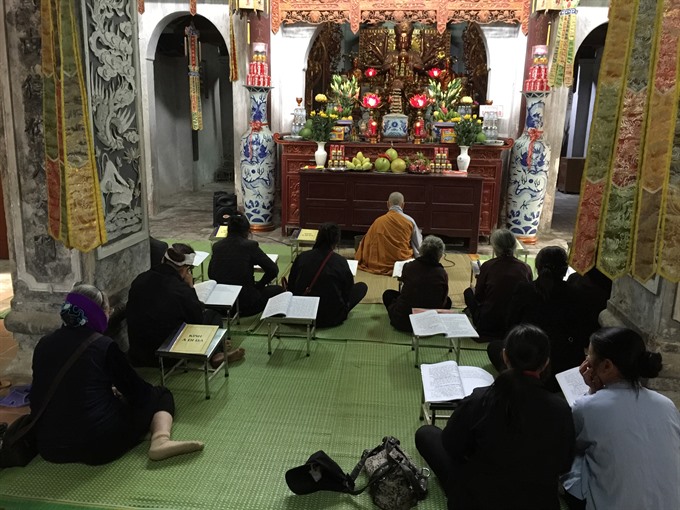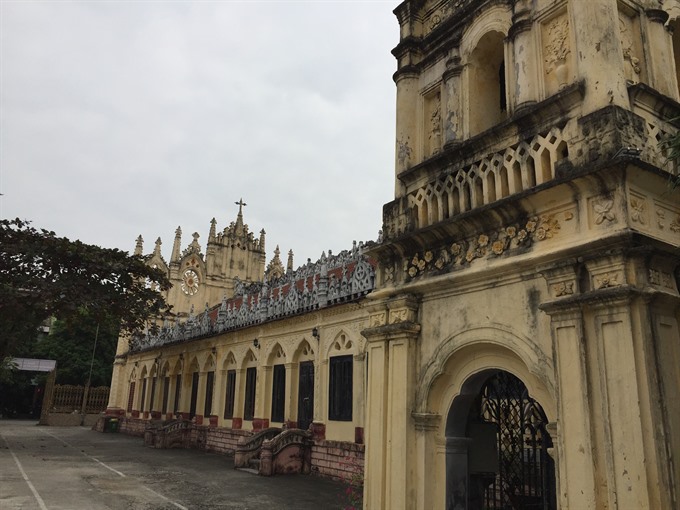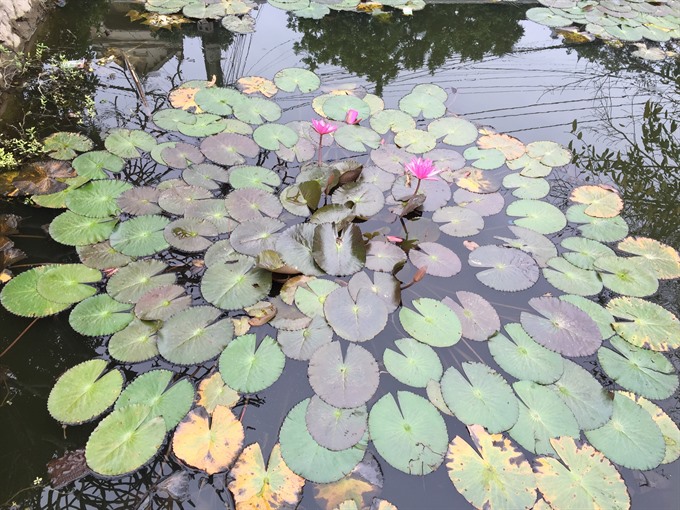 Features
Features

" />We visited historical relics in a special complex bearing remarks of the once famous area, Phố Hiến, on the right bank of the Hồng (Red) River.
 |
| Spirituality: Locals at a worship ceremony at Hiến Pagoda. VNS Photo Trần Mai Hưởng |
By Trần Mai Hưởng
We left Hà Nội, travelling along the right bank of the Hồng (Red) River to visit historical relics in a special complex bearing remarks of the once famous area.
It had the old saying “Thứ nhất Kinh kỳ, thứ nhì Phố Hiến” (The most important area is the Imperial capital city [Thăng Long], the second is Hiến Town).
The famed town hosts more than 100 relic sites including Xích Đằng Literature Temple, Bell Pagoda and Hiến Pagoda. It also hosts Trần Temple, Mây Temple and Mother Temple.
Visiting the old town, one may share the same regret with me as the leading trading centre in the north of the country in the 17th century, a small bustling Tràng An is now found only in traces.
In the middle of the 17th century, with the advantage of an entry way to Thăng Long Capital, Hiến Town had quickly developed from a residential area into a big economic hub.
Traders from China, Japan, Thailand, the Netherlands and Portugal came here to set up businesses.
At that time, Hiến Town was a river port with many markets. The town hosted 20 wards, many streets, shops and two trading centres. According to historical documents, the name Phố Hiến was adopted in the 15th century, when the head of the Sơn Nam area (the northern area of Thăng Long) established an administrative office.
 |
| Solemn: Mother Temple with lots of big trees. VNS Photo Trần Mai Hưởng |
After its golden years in the mid-17th century, the growth of Hiến Town was stunted due to various reasons. The Chinese market had started to open, Japan changed its development policy, and trading relations together with sea routes in the region developed.
In the meantime, a change in the location of the political and economic centre from Thăng Long in the north to Huế in the central region, social upheavals and even changes in the Red River’s currents resulted in setbacks for the town.
In 1831, under the reign of King Minh Mạng (1820-1841), Hưng Yên Province was formed, with the administrative centre built in the old Hiến Town. The important port location moved to Hải Phòng City.
Reaching Hiến Town, we passed by some relics of the once bustling port.
Our first destination was Xích Đằng Literature Temple, which was built in Xích Đằng Village in the 17th century.
The temple was a cultural hub of the Sơn Nam Area dedicated to Chinese philosopher Confucius (551-479BC) and Vietnamese scholar Chu Văn An (1292-1370). It is a fairy large construction with traditional architectural features with one of its gates looking like the one in the Temple of Literature in Hà Nội.
 |
| Multi-cultural: Hiến Town’s church was built by Dutch people in 1650. VNS Photo Trần Mai Hưởng |
The Xích Đằng Literature Temple hosts nine stone steles recording names of 138 PhD holders at royal examinations from the Trần Dynasty (1225-1400) up to the last feudal royal examination of 1919.
Chuông (Bell) Pagoda is a special destination in the Phố Hiến relic site complex. The pagoda has also been known as Kim Chung Tự (the Pagoda of Golden Bell), which is held by a legend that during a heavy flood, a golden bell floated here. Residents in the nearby Nhân Dục Village fished out the bell and built the pagoda to keep it.
The pagoda was built in the 15th century and was renovated in the 18th century, keeping its traditional design. On the tiled roof of the pagoda wasthe figure of a golden bell. There is a stone stele dating back to 1711 recording a beautiful scene of Phố Hiến and some wards in the town’s golden age.
Hiến Pagoda is also a famous tourist stop. The pagoda hosts two stone stelae dating back to 1625 and 1709, mentioning the formation and establishment of the ancient Hiến Town.
There is a big longan tree that locals consider to be the original ancestor of all the longan trees in the region. Hưng Yên is famed for its sweet and good flavoured longans.
Leaving the pagoda we came to Mẫu (Mother) Temple, which worships Yang Guifei (AD719-756), known as one of the four beauties of ancient China. The temple was believed to be built by Chinese traders, who once settled down here.
The holy temple has a solemn beauty with various big trees including an ancient banyan, which is over 700 years old. The temple is frequented by large numbers of tourists, even on weekdays.
Hiến Town’s Church is one of the oldest in the north. In 1650, the Dutch built the church from wood to serve western traders. Though the church is not very big, it bears a classic beauty, evidence of a multi-cultural community in the once glorious Hiến Town.
Today’s Hiến Town is a part of Hưng Yên City, which while young, possesses a great strength of character.
Taking a ride around the city, one can feel that power. Hưng Yên City has turned out to be an alluring investment destination. Many modern high- rises have been built and main roads are being upgraded. Various bridges including Yên Lệnh and Triều Dương crossing the Red River and the Luộc River have helped link Hưng Yên to other provinces.
Nguyễn Duy Hưng, deputy director of the Hưng Yên’s People’s Committee, told Việt Nam News that the city has great potential in developing tourism in handicraft villages.
He named the Phương Chiểu longan processing village, the Huệ Lai silver carving village, and the Lộng Thượng bronze casting village, as well as the Thủ Sỹ bamboo fish trap village and the Xuân Quan ceramic village as examples.
“The villages have not only preserved cultural values but have also made considerable contributions to developing the rural economy in the area,” he said.
Trần Đăng Tuấn, director of the Hưng Yên Culture and Sports Department, said there are a total of 49 handicraft villages in the province, 36 of which have been recognised by local authorities, with a total income of VNĐ6,700 billion (US$293.6 million). The handicrafts that tend to develop quickly include fine-art souvenirs, wood furniture, and ceramics, and also bamboo and rattan wares, and agricultural processing products.
There are tours to eight local craft villages such as making soya sauce in Bần, making incense in Cao Thôn, and rice wine in Trương Xá.
 |
| National symbol: The lake at Bell Pagoda. VNS Photo Trần Mai Hưởng |
 |
| Alive with history: Statues at Bell Pagoda. VNS Photo Trần Mai Hưởng |
There are around 400 traditional festivals in the province throughout the year, three of which have been preserved as intangible culture projects including the Đậu An Temple Festival in An Viên Commune, the water procession festivals at Đa Hòa Temple in Bình Minh Commune and Hóa Temple in Dạ Trạch Commune, and the Rain Worship Festival in Lạc Hồng Commune.
Many festivals gather thousands of tourists. These include the Hải Thượng Lãn Ông Festival dedicated to the famed "medical saint" of the country Lê Hữu Trác (1720-1791) and the Chử Đồng Tử-Tiên Dung Festival, which follows a legend of love between a poor man and the daughter of the 18th Hùng King.
Tourists visiting Hưng Yên may lose themselves in the folk melodies of ca trù (ceremonial singing) and chèo (traditional opera) sung by local farmers.
Hưng Yên Province has various delicacies such as longans, lotus seeds, and Đông Tảo chicken - a species of chicken with big feet, red skin and tender, delicious meat which is a rare species in Việt Nam that used to be served only to kings.
The government has approved a master plan to preserve and develop the historic and cultural values of the ancient town and promote tourism by 2020.
"The authorities will rebuild ancient buildings such as trading centres, houses, Chinese and Japanese boats and relic sites," Hưng said.
"A river port is being built for tourists going on cruises along the Red River to visit Hiến Town. Various folk games and traditional music performances will be re-organised to serve tourists." VNS